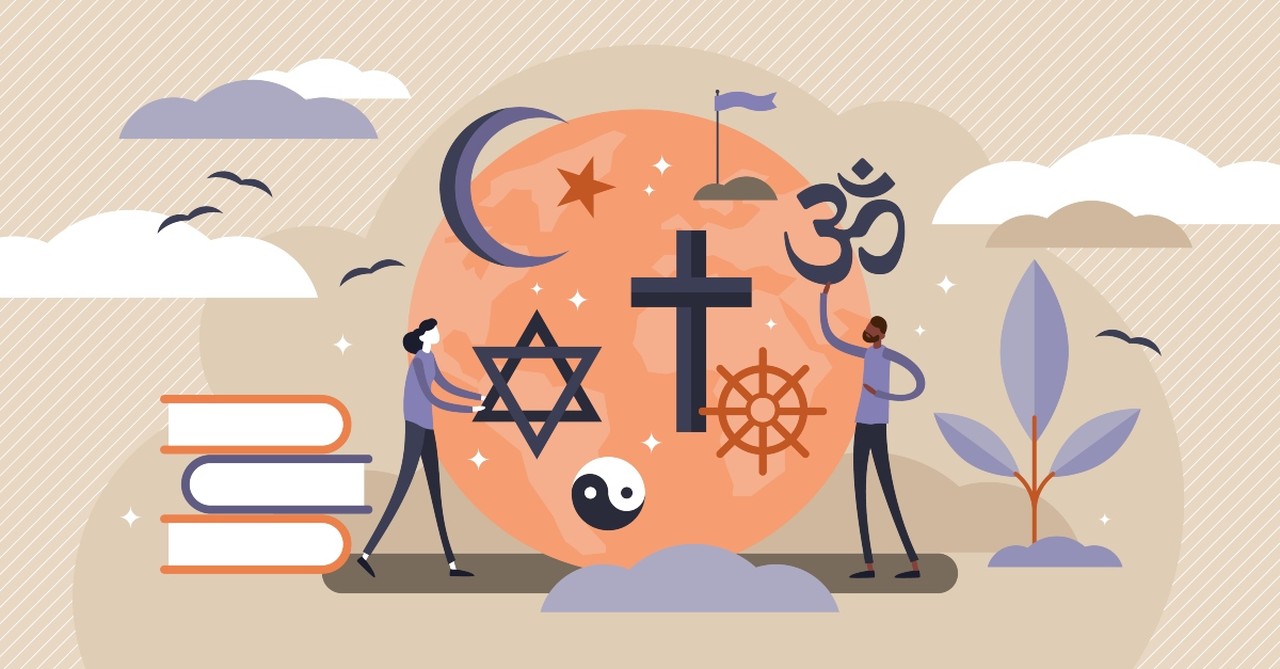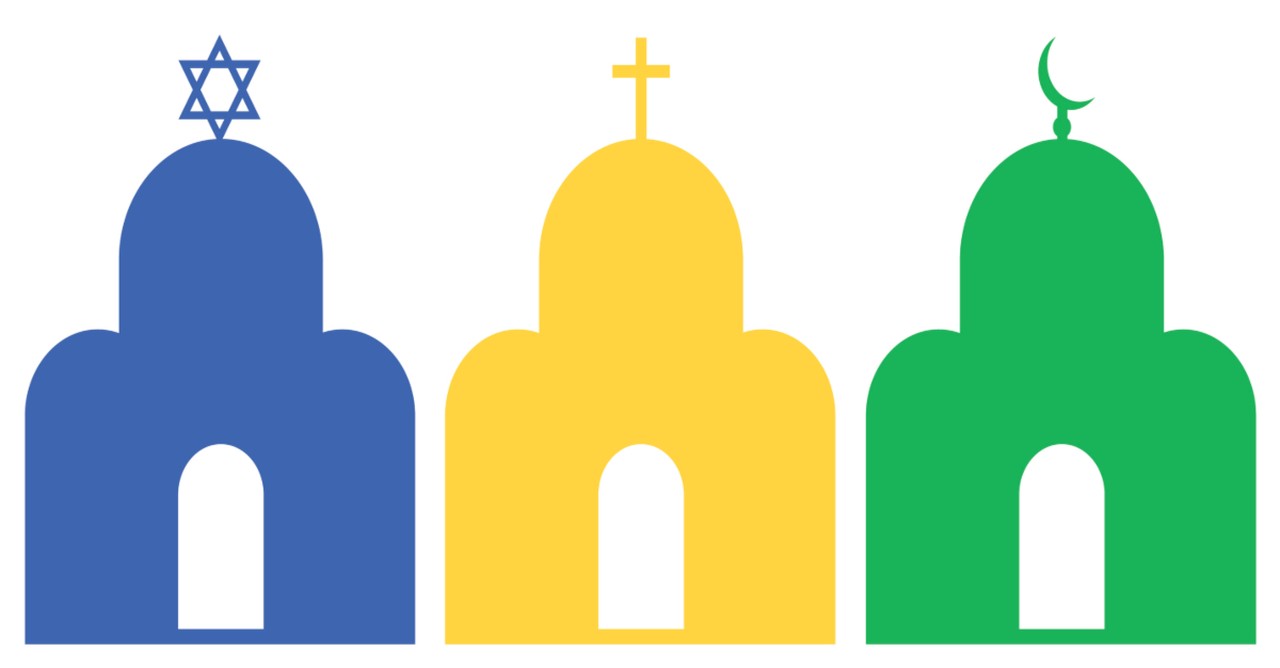What Does It Truly Mean to “Coexist” with Others?

The time had inevitably come: My daughter was going off to college. I was leading the caravan of vehicles loaded down with every single thing she was certain she would need in her dorm room. As I thought of my daughter and the days of wonder that had preceded that one, I stayed alert on the roadway, navigating the usual pandemonium that often ensues when traffic is heavy on a major interstate highway.
The sedan that raced across three lanes of traffic into my own, nestling its rear bumper only six to eight feet from the grill of my truck, was adorned with a brightly colored bumper sticker that featured a one-word message: COEXIST.
I’ve seen the sticker countless times since it was first created in 2000. But this time, the word awakened something different within me.
Photo Credit: ©Getty Images/VectorMine
Numerous World Religions Coming Together on a Vinyl Sticker

Numerous World Religions Coming Together on a Vinyl Sticker
SLIDE 1 OF 4
The vinyl sticker features the symbols of various world religions and practices arranged in such a way that they come together to spell the word coexist.
The “C” is made from the crescent moon, representing Islam. The “O” is made from the peace sign, originally created by a British graphic designer in 1958 for the British Campaign for Nuclear Disarmament.
The “E” is formed from the Hindu Om symbol. The Star of David serves as the “X,” and a pentacle, a Wiccan symbol, dots the “I” in the word. The Yin-yang symbol is used as the “S,” and finally, the Christian cross makes for the perfect “T” to finish the word.
The Idea of Coexistence
Though the message behind the creation of the “coexist” symbol is a positive one—centering on encouraging those who see it to coexist or live cohesively with others around them—it falls short of God’s design for us and our relationships and interactions with other people.
It’s not nearly enough to simply coexist with others.
Existing is not living. It’s not experiencing. It’s not interacting with others. In fact, existing requires little to no effort from a human being. Existing is simply the act of being alive. Co-existing, therefore, is just the act of being alive in the same place at the same time as another human being.
The act of existing or coexisting doesn’t involve weaving together the fabrics of people of different beliefs and cultures. Simply coexisting doesn’t create opportunities for us to practice kindness and compassion. It barely creates a scenario in which we practice tolerance.
And tolerance is not loving one another.
In John 10:10, Jesus explained why He came to earth, comparing His reasons to those of the Enemy.
“The thief comes only to steal, kill, and destroy, but I have come that they may have life—and life abundantly.”
Jesus made it clear that God’s plan is for His children to live life fully—not to merely exist.
Photo Credit: ©Getty Images/Bulat Silvia
Some Things Cannot Coexist

Some Things Cannot Coexist
SLIDE 2 OF 4
The gears in my busy mind kept turning, and after coming to the realization that mere existence has never been God’s plan, I became keenly aware of the many things in this world that simply cannot coexist—no matter how hard we might try—though today’s society has proudly created a thought culture and lifestyle of pretending that everything can live cohesively.
In our world, talk of love, tolerance, and understanding often overtakes the conversation. Oftentimes, however, that talk is nothing more than lip service—a way of attempting to make ourselves feel better or a way to try to mask the lack of love and compassion we secretly harbor.
A narrative centered on the love and acceptance of others simply cannot coexist with an attitude of hate and a cold heart toward others.
Love and hate cannot coexist in the heart of the same person. A heart so full of hate that it’s nearly bursting cannot host love, though society and mainstream media might have us believe otherwise. We can bear distaste in word and deed toward people we have categorized as wrong, immoral, or unimportant because of a difference in our beliefs, our culture, or the color of our skin, and on the same day, we speak to those we’ve categorized as worthy, moral, and in the right about God’s love.
Photo Credit: © Getty Images/Muhamad Chabib alwi
God Is Love

God Is Love
SLIDE 3 OF 4
But in the fourth chapter of 1 John, we are given a directive above love—and an explanation of where it can and cannot exist.
The apostle writes, “Dear friends, let us love one another, for love comes from God. Everyone who loves has been born of God and knows God, but whoever does not love does not know God, because God is love.” (1 John 4:7-8)
God created the universe and every living thing within it—including you and me, our friends, and our families. He also created those with whom we disagree, those who ascribe to different lifestyles, beliefs, and practices.
And these verses convey God’s message clearly—that it is His plan for us to love each other because He is the author of love.
He also makes it clear in His Word that those who love others are in line with His plan, and those who do not love others simply do not know God, as He is love.
Practicing Putting Others First
Not only does God expect us to live at peace with others, but He also calls on us to think of others first.
In the book of Philippians, Paul instructs believers to refrain from being selfish and not to be motivated by a spirit of selfishness. Instead, we are to be humble and value others—even to the point of putting their needs ahead of our own.
In the second chapter of Philippians, the apostle Paul writes to the congregation at the church at Philippi with a warning and a directive, saying, “Don’t do anything out of selfish ambition or vain conceit. Instead, in humility, value others above yourselves, not looking to your own interests but each of you to the interests of the others.”
Selfishness is an unflattering garment, no matter who wears it, and that’s because it goes against God’s intentional design for the way we are to treat others.
Photo Credit: ©Getty Images/C Cahill
God’s Design for Us to Live with Others Is Clear

God’s Design for Us to Live with Others Is Clear
SLIDE 4 OF 4
There’s something else that is clearly on God’s heart when it comes to how we coexist—or live—with others.
The New Testament book of Romans explains in detail how we are to treat others and how we are to relate to others, regardless of who they are.
In Romans 12:18, the Apostle Paul writes to the church in Rome, urging believers to examine how they relate to and respond to others, especially to those who don’t practice kindness and goodness toward others.
Paul writes, “As far as it depends on you, live at peace with everyone,” but in verses before and after this one, believers get a very clear understanding of God’s design and plan for us when it comes to interacting with others.
In verse 20, we are given instructions about how to treat our enemies: “If your enemy is hungry, feed him, and if he is thirsty, give him something to drink.” (Romans 12:20)
The chapter also teaches believers that we are not to attempt to repay or overcome evil with evil. Rather, God’s design calls on us to overcome evil with goodness and love. (Romans 12:21)
Romans 12 also tells us that we are to “practice hospitality” toward others. Instead of cursing those who persecute us, we are to pray for them and bless them. In Romans 12:16, believers are also instructed to “live in harmony with one another” and not to be proud or unwilling to talk with, befriend, or associate with those who are less fortunate.
The Need Is Dire, and the Time Is Now
Our world is in desperate need of believers who are unafraid to follow God’s plan for showing love to others, regardless of a difference in beliefs, skin color, culture, or socioeconomic position.
In fact, there’s likely never been such a great need for love to be shown and shared across the globe.
Believers are called upon to be the hands and feet of Jesus. It’s God’s desire for us to willingly allow ourselves to be used to show the world His love and the free gift of salvation that He offers as we place our faith and trust in Jesus as our Savior—salvation that will set them free to fully live as He has planned for us—rather than just existing.
Is there someone in our lives today who needs a kind word to hear the good news about salvation in Christ? And if we don’t share those things, who will?
Photo Credit: © Getty Images/Ojimorena
Becky Tyndall Burkett is from Texas and has been writing for more than 20 years. A wife and mom of four, she appreciates the incomparable worth of the family unit in everyday life, and she understands the invaluable role a relationship with Jesus plays in our daily walk.
After losing her mother while she was in college, Becky struggled to make sense of God’s will, but over time, in His goodness, He gave her beauty for ashes and gladness for mourning (Isaiah 61:3), using it to grow her faith in the Lord and her heart for others experiencing the pain of loss.
Becky is a professional creative writer and children’s author with years of experience in print journalism and online content writing. She has written several children’s books, including Coco Juego, Sandcastles for Sean: A Yellow Story, and You, Only You, among others. Becky is also the author of Farewell Performance, a beautiful tale of God’s will and His presence during our grief told in the story of a loving theater owner and a sparkling stage show that was gone too soon.
She’s currently writing a memoir about her grandparents and their lives’ journeys, titled I’ll See You in the Morning.
You can find her on her Facebook page, Lifted, on LinkedIn, and view her online portfolio at Authory.com.
Originally published September 09, 2024.









